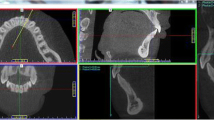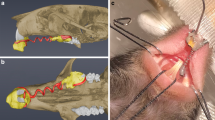Abstract
Purpose
During mastication, mechanical pressure from the dentition is transmitted to the trabecular bone of the mandible. The occlusal forces, which could thus affect condylar growth, vary with tooth loss, age, and sex. The trabecular bone of the mandibular condyle is denser in dentate subjects than in edentate subjects. However, since the different tooth groups (incisor, premolar, and molar) have different functions, they could exert different effects on the mandibular condyle. The aim of this study was to elucidate the bone quantity of the Korean mandibular condyle according to the presence of teeth using micro-computed tomography (micro-CT), thereby clarifying the influences of tooth presence on the condylar microstructure.
Methods
Thirty-one sides were scanned and reconstructed into a 3D structure using a micro-CT system. The specimen was sectioned vertically, passing through the medial and lateral poles of the mandibular condyle (P0) to enable measurement of the trabecular bone ratio. Likewise, three additional images, parallel with P0, were acquired. Mean and standard deviation values were calculated, and the t test, one-way ANOVA and post hoc analysis were performed to examine the differences among each group, classified according to the presence of teeth and according to sex.
Results
The density of the trabecular bone of the mandibular condyle was significantly associated with the presence of the molars, but not the incisors or premolars. There were significant differences between sexes.
Conclusions
The present study has provided data regarding the bone quantity of the trabeculae of the mandibular condyle according to the presence or absence of teeth.




Similar content being viewed by others
References
Bitterling H, Vogel T, Dobler T, Mutschler W, Pfeifer KJ, Reiser M, Eibel R (2005) Role of osteoporosis in trauma diagnostics. Rofo 177(12):1663–1669
Bresin A, Kiliaridis S, Strid KG (1999) Effect of masticatory function on the internal bone structure in the mandible of the growing rat. Eur J Oral Sci 107(1):35–44
Chrcanovic BR, Abreu MH, Custodio AL (2011) Morphological variation in dentate and edentulous human mandibles. Surg Radiol Anat 33(3):203–213
de Oliveira Junior MR, Saud AL, Fonseca DR, De-Ary-Pires B, Pires-Neto MA, de Ary-Pires R (2011) Morphometrical analysis of the human mandibular canal: a CT investigation. Surg Radiol Anat 33(4):345–352
de Souza Fernandes AC, de Quadros Uzeda-GonzalezS, Smith RL, Alonso LG, Gonzalez FM, Santos MV (2010) Tomographic analysis of the interalveolar space and thickness of the vestibular cortical bone in the parasymphyseal region of adult human mandibles. Surg Radiol Anat 32(10):951–956
Drozdzowska B, Pluskiewicz W, Tarnawska B (2002) Panoramic-based mandibular indices in relation to mandibular bone mineral density and skeletal status assessed by dual energy X-ray absorptiometry and quantitative ultrasound. Dentomaxillofac Radiol 31(6):361–367
Engelke K, Song SM, Gluer CC, Genant HK (1996) A digital model of trabecular bone. J Bone Miner Res 11(4):480–489
Giesen EB, Ding M, Dalstra M, van Eijden TM (2004) Changed morphology and mechanical properties of cancellous bone in the mandibular condyles of edentate people. J Dent Res 83(3):255–259
Gulsahi A, Yuzugullu B, Imirzalioglu P, Genc Y (2008) Assessment of panoramic radio morphometric indices in Turkish patients of different age groups, gender and dental status. Dentomaxillofac Radiol 37(5):288–292
Henrikson PA, Wallenius K (1974) The mandible and osteoporosis (1). A qualitative comparison between the mandible and the radius. J Oral Rehabil 1(1):67–74
Hongo T (1987) Quantitative and morphological studies on the trabecular bones in the processus condylaris of the Japanese mandible: comparison between dentulous and edentulous specimens and differences in ages. Shikwa Gakuho 87(12):1583–1611
Kawashima T, Abe S, Okada M, Kawada E, Saitoh C, Ide Y (1997) Internal structure of the temporomandibular joint and the circumferential bone: comparison between dentulous and edentulous specimens. Bull Tokyo Dent Coll 38(2):87–93
Kurusu A, Horiuchi M, Soma K (2009) Relationship between occlusal force and mandibular condyle morphology. Evaluated by limited cone-beam computed tomography. Angle Orthod 79(6):1063–1069
Laffosse JM, Kinkpe C, Gomez-Brouchet A, Accadbled F, Viguier E, Sales de Gauzy J, Swider P (2010) Micro-computed tomography study of the subchondral bone of the vertebral endplates in a porcine model: correlations with histomorphometric parameters. Surg Radiol Anat 32(4):335–341
Merrot O, Vacher C, Merrot S, Godlewski G, Frigard B, Goudot P (2005) Changes in the edentate mandible in the elderly. Surg Radiol Anat 27(4):265–270
Moon HS, Won YY, Kim KD, Ruprecht A, Kim HJ, Kook HK, Chung MK (2004) The three-dimensional microstructure of the trabecular bone in the mandible. Surg Radiol Anat 26(6):466–473
Muhlberger G, Svejda M, Lottersberger C, Emshoff R, Putz R, Kuhn V (2009) Mineralization density and apparent density in mandibular condyle bone. Oral Surg Oral Med Oral Pathol Oral Radiol Endod 107(4):573–579
Savoldelli C, Bouchard PO, Loudad R, Baque P, Tillier Y (2011) Stress distribution in the temporo-mandibular joint discs during jaw closing: a high-resolution three-dimensional finite-element model analysis. Surg Radiol Anat. doi:10.1007/s00276-011-0917-4
Solar P, Ulm CW, Thornton B, Matejka M (1994) Sex-related differences in the bone mineral density of atrophic mandibles. J Prosthet Dent 71(4):345–349
Toure G, Duboucher C, Vacher C (2005) Anatomical modifications of the temporomandibular joint during ageing. Surg Radiol Anat 27(1):51–55
Von Wowern N (1982) Microradiographic and histomorphometric indices of mandibles for diagnosis of osteopenia. Scand J Dent Res 90(1):47–63
von Wowern N (1985) In vivo measurement of bone mineral content of mandibles by dual-photon absorptiometry. Scand J Dent Res 93(2):162–168
Won SY, Kim SH, Kim ST, Paik DJ, Song WC, Koh KS, Chung MK, Kim HJ, Hu KS (2010) Trabecular bone ratio of mandible using micro-computed tomography in Korean. J Craniofac Surg 21(3):920–924
Acknowledgments
This research was supported by Basic Science Research Program through the National Research Foundation of Korea (NRF) funded by the Ministry of Education, Science and Technology (R13-2008-013-03001-0).
Author information
Authors and Affiliations
Corresponding author
Additional information
D.Y. Choi and K.H. Sun equally contributed.
Rights and permissions
About this article
Cite this article
Choi, D.Y., Sun, K.H., Won, S.Y. et al. Trabecular bone ratio of the mandibular condyle according to the presence of teeth: a micro-CT study. Surg Radiol Anat 34, 519–526 (2012). https://doi.org/10.1007/s00276-012-0943-x
Received:
Accepted:
Published:
Issue Date:
DOI: https://doi.org/10.1007/s00276-012-0943-x




